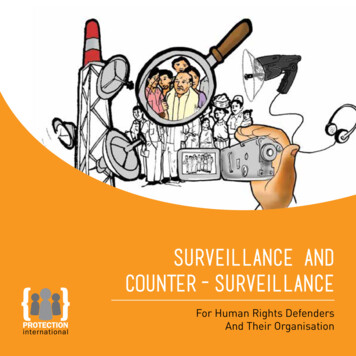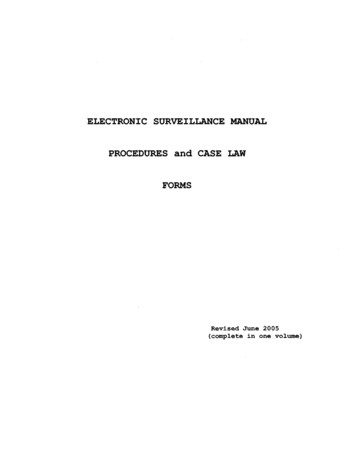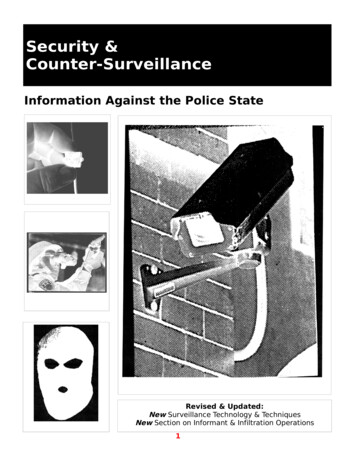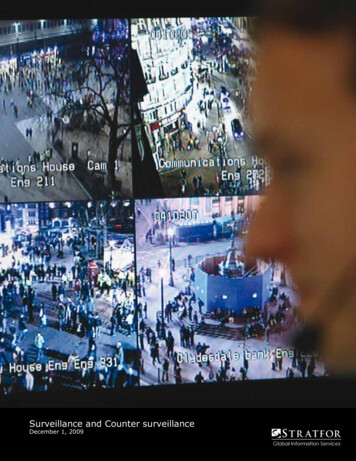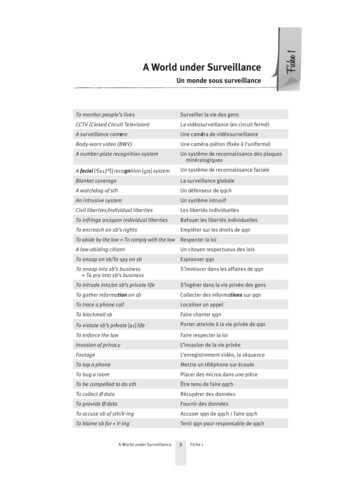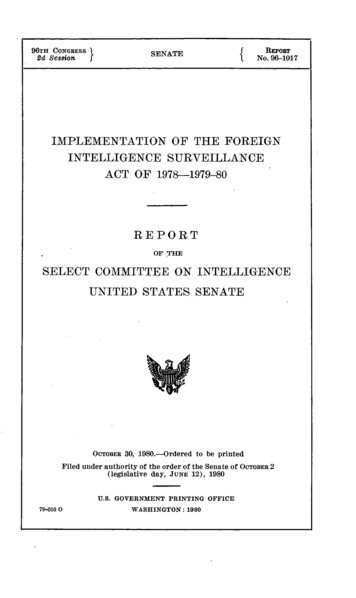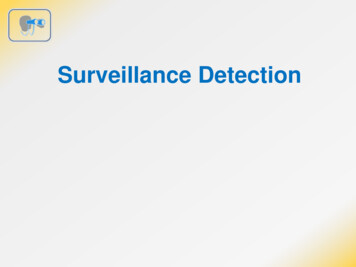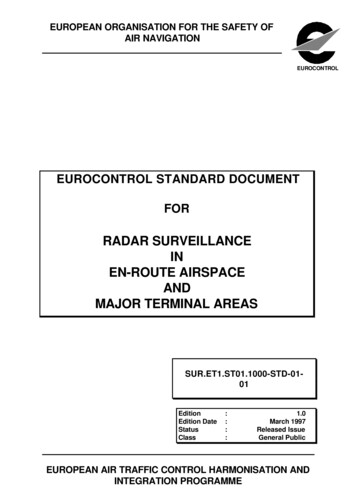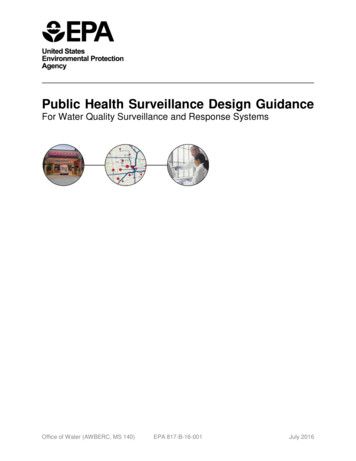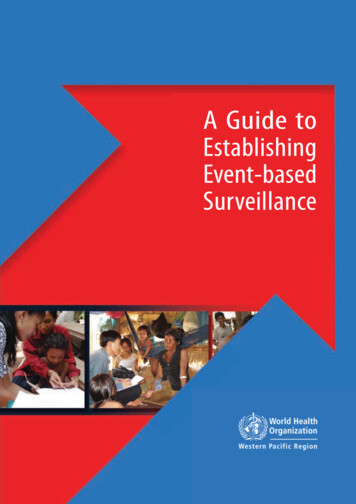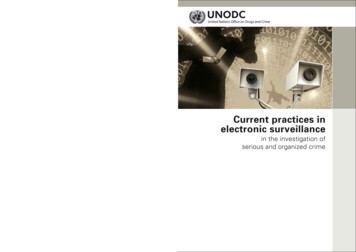
Transcription
Vienna International Centre, PO Box 500, 1400 Vienna, AustriaTel.: ( 43-1) 26060-0, Fax: ( 43-1) 26060-5866, www.unodc.orgCurrent practices inelectronic surveillancein the investigation ofserious and organized crimeUnited Nations publicationISBN ?-?-?-?-?ISSN ?-?Sales No. T.08.XI.7ST/NAR.3/2007/1 (E/NA)FOR UNITED NATIONS USE ONLYPrinted in AustriaV.09-86322 —October 2009—500
UNITED NATIONS OFFICE ON DRUGS AND CRIMEViennaCurrent practices inelectronic surveillance in the investigation ofserious and organized crimeUnited NationsNew York, 2009
UNITED NATIONS PUBLICATIONSales No. E.09.XI.19ISBN 978-92-1-148246-1
Contents1. INTRODUCTION. . . . . . . . . . . . . . . . . . . . . . . . . . . . . . . . . . . . . . . . . . .11.1 The issue . . . . . . . . . . . . . . . . . . . . . . . . . . . . . . . . . . . . . . . . . . . . . . .11.2 “Electronic surveillance” . . . . . . . . . . . . . . . . . . . . . . . . . . . . . . . . . . .21.3 The process . . . . . . . . . . . . . . . . . . . . . . . . . . . . . . . . . . . . . . . . . . . . .21.4 Objectives . . . . . . . . . . . . . . . . . . . . . . . . . . . . . . . . . . . . . . . . . . . . . .31.5 Scope . . . . . . . . . . . . . . . . . . . . . . . . . . . . . . . . . . . . . . . . . . . . . . . .31.6 Structure . . . . . . . . . . . . . . . . . . . . . . . . . . . . . . . . . . . . . . . . . . . . . . .41.7 Definitions. . . . . . . . . . . . . . . . . . . . . . . . . . . . . . . . . . . . . . . . . . . . . .42. MULTILATERAL AND INTERNATIONAL APPROACHESAND ISSUES . . . . . . . . . . . . . . . . . . . . . . . . . . . . . . . . . . . . . . . . . . . . . . .72.1 The international framework. . . . . . . . . . . . . . . . . . . . . . . . . . . . . . . .72.2 Cross-border cooperation. . . . . . . . . . . . . . . . . . . . . . . . . . . . . . . . . . .992.2.1 Cross-border cooperation: jurisdictional issues and challenges.2.2.2 Intangible data held on computer networksspanning several countries. . . . . . . . . . . . . . . . . . . . . . . . . . . . . 102.2.3 Mutual legal assistance treaties (MLATs) . . . . . . . . . . . . . . . . . 102.2.4 Multilateral agreements. . . . . . . . . . . . . . . . . . . . . . . . . . . . . . . 102.2.5 Other networks and programmes. . . . . . . . . . . . . . . . . . . . . . . 113. regulation: warrants and authorizations . . . . . . . . . 133.1 When is a warrant or authorization required? . . . . . . . . . . . . . . . . . . 133.2 The applicant. . . . . . . . . . . . . . . . . . . . . . . . . . . . . . . . . . . . . . . . . . . . 143.3 The authorizing body . . . . . . . . . . . . . . . . . . . . . . . . . . . . . . . . . . . . . 153.3.1 Who authorizes the use of electronic evidencegathering techniques?. . . . . . . . . . . . . . . . . . . . . . . . . . . . . . . . . 153.3.2 Surreptitious electronic evidence gathering by consent. . . . . . . 163.4 Notice . . . . . . . . . . . . . . . . . . . . . . . . . . . . . . . . . . . . . . . . . . . . . . . . 173.5 Contents of warrant application. . . . . . . . . . . . . . . . . . . . . . . . . . . . . 173.6 Justification for warrant. . . . . . . . . . . . . . . . . . . . . . . . . . . . . . . . . . . . 183.7 What a warrant authorizes . . . . . . . . . . . . . . . . . . . . . . . . . . . . . . . . . 19iii
3.7.1 Scope. . . . . . . . . . . . . . . . . . . . . . . . . . . . . . . . . . . . . . . . . . . . . 193.7.2 Duration . . . . . . . . . . . . . . . . . . . . . . . . . . . . . . . . . . . . . . . . . . 213.8 Use of surveillance data. . . . . . . . . . . . . . . . . . . . . . . . . . . . . . . . . . . . 213.8.1 Use of surveillance data: intercepted communications. . . . . . . 213.8.2 Transcription. . . . . . . . . . . . . . . . . . . . . . . . . . . . . . . . . . . . . . . 223.8.3 Information obtained about persons or offencesnot the subject of the warrant . . . . . . . . . . . . . . . . . . . . . . . . . 233.8.3 Chain of custody. . . . . . . . . . . . . . . . . . . . . . . . . . . . . . . . . . . . 233.9 Reporting requirements. . . . . . . . . . . . . . . . . . . . . . . . . . . . . . . . . . . . 243.9.1 Reports to issuing judge. . . . . . . . . . . . . . . . . . . . . . . . . . . . . . 243.9.2 Annual reports. . . . . . . . . . . . . . . . . . . . . . . . . . . . . . . . . . . . . . 253.10 Implications of non-compliance . . . . . . . . . . . . . . . . . . . . . . . . . . . . . 253.11 Emergency or urgent circumstances . . . . . . . . . . . . . . . . . . . . . . . . . . 264. Other principles governing electronicevidence gathering by law enforcement. . . . . . . . . . . . 294.1 Reasonable expectancy of privacy. . . . . . . . . . . . . . . . . . . . . . . . . . . . 294.1.1 Right to respect for private life in the European Courtof Human Rights . . . . . . . . . . . . . . . . . . . . . . . . . . . . . . . . . . . 305. Additional Policy Considerations . . . . . . . . . . . . . . . . . . . 335.1 Regulation of other users of electronic surveillance: private security . . 335.2 Regulating the use of changing technologies . . . . . . . . . . . . . . . . . . . 336. additional challenges. . . . . . . . . . . . . . . . . . . . . . . . . . . . . . . . 356.1 Resource constraints . . . . . . . . . . . . . . . . . . . . . . . . . . . . . . . . . . . . . . 356.2 Training. . . . . . . . . . . . . . . . . . . . . . . . . . . . . . . . . . . . . . . . . . . . . . . . 356.3 Technological challenges . . . . . . . . . . . . . . . . . . . . . . . . . . . . . . . . . . . 366.3.1 Telephone number portability and roaming. . . . . . . . . . . . . . . 366.3.2 Email, chat and voice over internet protocol (VOIP) . . . . . . . 366.3.3 Pre-paid mobile telephones and internet cafés. . . . . . . . . . . . . 376.3.4 Telecommunications service providers. . . . . . . . . . . . . . . . . . . . 376.3.5 Tracking. . . . . . . . . . . . . . . . . . . . . . . . . . . . . . . . . . . . . . . . . . . 387. Request for comment . . . . . . . . . . . . . . . . . . . . . . . . . . . . . . . . . 39iv
1. Introduction1.1. The issueThe value of employing electronic surveillance in the investigation of some forms ofserious crime, in particular organized crime, is unquestionable. It allows the gathering ofinformation unattainable through other means. Some countries have utilized surreptitiouselectronic surveillance for nearly a century. For others it is a more recent phenomenon, andfor some it is not yet utilized at all.The use by law enforcement of electronic surveillance should not be an investigative toolof first resort, instead its use should be considered when other less intrusive means haveproven ineffective or when there is no reasonable alternative to obtain crucial informationor evidence. Even when electronic surveillance is appropriate, it will generally need to beused in conjunction with other investigation methods in order to be most effective.For those jurisdictions without any regulation, or with legislation which is lacking in somerespect, the challenge is to develop a balanced system for the use of electronic evidencegathering. The balance which needs to be struck is that between the effective use ofelectronic evidence gathering and the protection of citizens’ rights. This includes balancingthe cost of utilizing these methods against the ultimate public benefit gained from aconviction. These considerations should be weighed carefully by legislators, prosecutors,law enforcement and the like.It should also be noted that in some countries the existence of a federal system of gover nance means that electronic surveillance can be regulated at both a local and at a nationallevel. Federal law will often apply where the investigation is into crime that crosses borders,however, organized crime is of course also investigated by local law enforcement. It is notpossible for this document to comprehensively consider regulation of individual states,regions or provinces within countries, although their mention will occur where valuableexamples arise.1
CURRENT PRACTICES IN ELECTRONIC SURVEILLANCE IN THE INVESTIGATION OF SERIOUS ORGANIZED CRIME1.2Electronic surveillanceThe term “electronic surveillance” covers an array of capabilities and practices. To betterunderstand what is meant by electronic surveillance, it is useful to break it down into parts.Surveillance has previously been defined on the basis of covert/overt distinctions, ordetermined according to the level of contact with the target, whether remote or direct.These distinctions might, arguably, create a false dichotomy, particularly in the contextof modern surveillance technologies, where overt/covert lines are not as easy to draw. Thus,a framework based on function is perhaps more useful. The table below provides someexamples. Although this too is flawed in that modern surveillance technologies will oftenhave multiple capabilities (see below discussion at section 5.2 on regulating technologieswith multiple capabilities).Audio surveillanceVisual surveillancePhone-tapping.Hidden video surveillance Global positioning systemsdevices.(GPS)/transponders.Voice over internet In-car video systems.protocol (VOIP).Listening devices(room bugging).Tracking surveillanceMobile phones.Body-worn video devices. Radio frequency identifi cation devices (RFID).Thermal imaging/forwardlooking infrared.Data ckberries/mobilephones.Keystroke monitoring.Biometric informationtechnology (retina scansat airports etc).CCTV.This document confines its consideration of surveillance practices to electronic surveillanceand not other forms of surveillance such as the use of covert operatives. Thus, for thepurposes of this document, the terms “surveillance” and “electronic surveillance” aresynonymous and used interchangeably.1.3 The processIn December 2007 the United Nations Office on Drugs and Crime (UNODC) commenced the first of a series of meetings with expert representatives from law enforcementand prosecutorial and judicial authorities of Member States. The first informal expert groupmeeting on electronic evidence gathering was held from 3-5 December 2007 at the ViennaInternational Centre. A second regional expert group meeting for South-East Asiancountries was held 17-18 March 2009 at the Digital Forensic Centre in Seoul. Themeetings each brought together a small group of law enforcement officials and legal expertsfrom different countries and regions. It is anticipated that more regular expert groupmeetings are to follow.The initial goal of these meetings was to utilize participants’ expertise and experiences todevelop a training manual for electronic surveillance. However, due to the complexity of2
Introductionthis issue, it was decided that as a first step it would be useful to draft a comparative studyof surveillance regulation and practices, drawing primarily upon the expert group meetingsbut also by completing more general research in the area. The document will broadlyoutline the use of and challenges faced by law enforcement and investigative authorities ina range of jurisdictions in the collection, use and storage of electronic evidence throughsurveillance.1.4 ObjectivesThe purpose of conducting a comparative study of electronic evidence gathering is tooutline current practices that will serve as an important reference tool for Member Statesin the regulation and use of electronic evidence gathering in the investigation of seriouscrime. Essentially, this document aims to: Contribute to an improved understanding of the global practical and legal issuespresented by the use of electronic surveillance in evidence gathering, handlingand use. Provide an account of the challenges faced by law enforcement and investigativeauthorities in the use of electronic evidence gathering in the investigation ofserious crime. Provide some guidance, options and ideas for countries developing policy orregulation of electronic evidence gathering in the investigation of crime.This document aims to assist legislative drafters, policymakers, legal practitioners, lawenforcement and other investigative authorities involved in or considering electronicevidence gathering. It hopes to provide a comprehensive outline of measures and optionswhich may be considered for incorporation into respective legal systems and operationalprocedures subject to the particular social, political and economic circumstances oftheir countries.1.5ScopeCountries with greater resources for policing and investigative techniques tend to have alonger history of both regulation and use of special investigative techniques. This will bereflected somewhat in the research, however, this does not represent any kind of bias, butmerely an unavoidable limitation reflective of modern and historical economic realities.Despite these limitations, the preparation of this document involved broad research acrossa range of regions, despite a scarcity of information in some. Thus a variety of jurisdictionsand approaches are considered. Further national examples will be added and expandedupon as they are provided by participants in ongoing regional expert group meetings.In this document, UNODC is concerned only with electronic surveillance for the investigations of serious crime. Although, it is acknowledged that electronic evidence gatheringtechniques may be appropriate for use in the investigation of less serious offences.3
CURRENT PRACTICES IN ELECTRONIC SURVEILLANCE IN THE INVESTIGATION OF SERIOUS ORGANIZED CRIME1.6StructureThis document begins by outlining the multilateral and international framework withinwhich electronic evidence gathering takes place in section two. Following this the focusshifts to national regimes in section three which pays particularly attention to the processand regulation of the authorization of electronic surveillance at a domestic level. Policyconsiderations, principles and rights which temper the use of electronic surveillanceare discussed in section 4. The primary concern in this regard is the protection of anindividual’s right to privacy, a right necessarily infringed in the conduct of surveillance.Section five canvasses the speed of technological development and the difficulties rapidtechnological advancement might present to legislators, as well as the regulation ofprivate security personnel. Finally section six concludes by discussing the technical andadministrative challenges associated with the use and regulation of electronic surveillance.1.7 DefinitionsWhere possible the following definitions have been taken from the United NationsConvention Against Transnational Organized Crime (TOCC):Organized criminal group shall mean a structured group of three or more persons,existing for a period of time and acting in concert with the aim of committing one or moreserious crimes or offences established in accordance with this Convention, in order toobtain, directly or indirectly, a financial or other material benefit.Serious crime shall mean conduct constituting an offence punishable by a maximumdeprivation of liberty of at least four years or a more serious penalty.1 (The jurisdictionaldisparities between what constitutes “serious crime” are discussed further below).Special investigation techniques means techniques applied by law enforcement in the context of criminal investigations for the purpose of detecting and investigating serious crimes,and aimed at gathering information in such a way as not to alert the target persons.2Warrant shall include “authorization” and “direction”.3Surveillance (or “electronic surveillance”) is rarely itself defined in the legislationdelineating its use. Instead, relevant provisions will often provide a definition of “intercept”,“communication” and other more device-specific definitions, which range from succinct to1United Nations Convention Against Transnational Organized Crime Art 2.Council of Europe Committee of Ministers, Recommendation Rec (2005) 10 of the Committee of Ministers to member states on“special investigative techniques” in relation to serious crimes including acts of terrorism, https://wcd.coe.int/ViewDoc.jsp?id 849269&BackColorInternet 9999CC&BackColorIntranet FFBB55&BackColorLogged FFAC75 at 5 February 2009.3The terms “authorization” and “direction” are used by some jurisdictions to denote an authority which is, for our purposes, thesame as that of a warrant, and thus these three terms are used interchangeably.24
Introductioncomplex. For the purposes of this document, and in the context of law enforcement,surveillance is the collection or monitoring of information about a person or persons throughthe use of technology. This document will focus on surveillance for the stated purpose ofpreventing crime or prosecuting offences.Electronic surveillance: see section 1.1.5
2. Multilateral and InternationalApproaches and Issues2.1 The international frameworkThe United Nations Convention Against Transnational Organized Crime (TOCC) isthe fundamental international instrument calling upon Member States to criminalizeorganized and serious crime globally. Its purpose is to promote cooperation to prevent andcombat transnational organized crime more effectively and constitutes the foundationdocument for the UNODC’s anti-organized crime initiatives. Article 20 of this documentrefers to “special investigative techniques”.Article 20 of the TOCC provides that:2. For the purpose of investigating the offences covered by this Convention, StatesParties are encouraged to conclude, when necessary, appropriate bilateral or multilateralagreements or arrangements for using such special investigative techniques in the contextof cooperation at the international level. Such agreements or arrangements shall beconcluded and implemented in full compliance with the principle of sovereign equality ofStates and shall be carried out strictly in accordance with the terms of those agreementsor arrangements.3. In the absence of an agreement or arrangement as set forth in paragraph 2 of thisarticle, decisions to use such special investigative techniques at the international level shallbe made on a case-by-case basis and may, when necessary, take into consideration financialarrangements and understandings with respect to the exercise of jurisdiction by the StatesParties concerned.7
CURRENT PRACTICES IN ELECTRONIC SURVEILLANCE IN THE INVESTIGATION OF SERIOUS ORGANIZED CRIMEThe domestic regulation of electronic surveillance does not occur in a vacuum. Regional andinternational considerations are also relevant, including domestic obligations under inter national instruments. The right which is most frequently referred to in this context and isgenerally most juxtaposed against the use of surveillance is the right to privacy. The right toprotection from arbitrary invasion of privacy is a fundamental human right, laid down inarticle 17 of the International Covenant on Civil and Political Rights (ICCPR). The ICCPRhas 160 state parties and thus creates obligations which stretch across most of the world.Article 17 of the ICCPR:1. No one shall be subject to arbitrary or unlawful interference with his privacy, family,home or correspondence, nor to unlawful attacks on his honour and reputation2. Everyone has the right to the protection of the law against such interference or attacksThe European Convention on Human Rights also contains a similar provision protectingthe privacy of its citizens. Claims in the European Court of Human Rights (ECHR) havebeen made pursuant to article 8 of the European Convention on Human Rights whichprotects the “right to respect for private life” (see further at 4.1.1 of this document).Article 8 of the European Convention on Human Rights stipulates:1. Everyone has the right to respect for his private and family life, his home and hiscorrespondence2. There shall be no interference by a public authority with the exercise of this rightexcept such as in accordance with the law and is necessary in a democratic society in theinterests of national security, public safety or the economic well-being of the country, forthe prevention of disorder or crime, for the protection of health or morals, or for theprotection of the rights and freedoms of others.The ECHR has dealt with several cases involving electronic surveillance conducted by lawenforcement.4 These are expanded upon further in section 4.1.1 of this document.Concern for the protection of the right to privacy has also been enshrined in theCoE’s European Code of Police Ethics. The Code specifically protects an individual’sright to privacy vis-à-vis police conduct. Further, the CoE Code stipulates that the use ofdata obtained by police shall be dealt with in accordance with international data protectionprinciples.54Case of the Association for European Integration and Human Rights and Ekimdzhiev v Bulgaria (no. 62540/00) 28 June 2007;Elahi v United Kingdom (no. 30034/04) 20 September 2006; Hewitson v United Kingdom (no. 50015/99) 27 August 2003; Khan vUnited Kingdom (no. 35394/97) 12 May 2000; Malone v United Kingdom (no. 8691/79) 2 August 1984. Note that the Human RightsAct 1998 (UK) adopted the European Convention on Human Rights into United Kingdom law and this may have contributed to adisproportionate increase in cases from the United Kingdom being brought before the ECHR in the last decade.5Council of Europe, European Code of Police Ethics, ss 41 and 42. The “data protection principles” were established in 1980 by theOECD. They broadly prohibit the unlawful storage of personal data, the storage of inaccurate personal data, or the abuse orunauthorized disclosure of such data.8
MULTILATERAL AND INTERNATIONAL APPROACHES AND ISSUES2.2 Cross-border cooperationAs organized crime increases its global reach, it is important that law enforcement alsohave (at least) reciprocal global capabilities. Indeed with the increased globalization oforganized criminal networks, the need for effective cross-border cooperation is likely toincrease. In practice, requests for assistance for cross-border electronic evidence gatheringor surveillance is often avoided for both practical reasons to do with efficacy, and frustration with bureaucratic delays.2.2.1Cross-border cooperation: jurisdictional issues and challengesCross-border investigations present unique challenges to law enforcement and otherinvestigating authorities. The use of electronic evidence gathering in another jurisdictionwill require a request from the investigating jurisdiction to the country in which surveillance is anticipated to occur. The latter will likely only pursue an investigation wherethe relevant offence is also an offence under their own criminal law. Practically this isoften the case. However, ongoing electronic evidence gathering from one jurisdictioninto another is rarely smooth or speedy. In the actual initiation of electronic evidencegathering, bureaucratic procedures and red-tape can cause relatively lengthy delays. Inaddition, the jurisdiction requested to conduct the surveillance will want to understandthe evidence so far obtained in order to determine whether an offence against theircriminal law, has been, is being, or is likely to be committed.Evidence obtained in a country other than that in which the criminal trial will occurcan be of questionable admissibility. Domestic law in this area is complex and invariably,jurisdictions will each possess somewhat different systems to maintain the chain ofcustody. More generally, where evidence has been gathered in a jurisdiction not the hostof the criminal trial, it may be difficult to satisfy the local legal requirements regardingadmissibility of evidence.In both expert group meetings, participants noted that requesting data from anotherjurisdiction is problematic. Challenges faced in this respect include: Delay; A lack of commitment and flexibility from the authority from which evidence isrequested; The form in which evidence is provided to the requesting jurisdiction is one thatcan cause prosecutorial challenges; Differing definitions of serious criminal offences between jurisdictions.9
CURRENT PRACTICES IN ELECTRONIC SURVEILLANCE IN THE INVESTIGATION OF SERIOUS ORGANIZED CRIME2.2.2 Intangible data held on computer networks spanningseveral countriesThe cross-jurisdictional challenge is compounded by the increase in intangible data heldon foreign servers but accessible locally. The 2009 expert group meeting raised the issue ofaccessing data hosted in another jurisdiction, such as information stored on a foreigncomputer network, but accessible domestically. Discussion centred on the extent to whichthis presents a legal predicament in which one of two implications will follow. Either itwill be necessary to limit what law enforcement can do, or law enforcement will beconducting investigations which could be unlawful in the jurisdictions hosting the datathey are accessing. This predicament is further exacerbated where the jurisdiction of thenetwork hosting the electronic data is not known.2.2.3Mutual legal assistance treaties (MLATs)Article 18 of the TOCC extends an obligation on states parties to provide mutual legalassistance in the investigation and prosecution of serious offences. The provision ofmutual assistance appears to be reflected in some, but few, of the national legislativeinstruments regulating electronic evidence gathering.6 Organizations such as EUROJUSTand EUROPOL facilitate and encourage cross-border cooperation regionally, but suchinitiatives are not found across all regions. Thus, there is scope for further development ofeffective strategies to assist and encourage mutual legal assistance in the investigation andprosecution of serious offences.Historically MLATs have played an important role in cross-border criminal investigation.In general such treaties seek to expedite and assist cross-border cooperation in criminalinvestigations. Usually each country will designate an authority for direct communicationbetween the countries or jurisdictions in such instances where cross-border assistance maybe required. However, no MLAT gives open permission for cross-border surveillance tooccur; they merely operate, in the most part, to create open lines of communication. Anauthorization or warrant is only valid in the country in which it was obtained. Ifcountry A wishes to conduct surveillance in country B it may offer the grounds on whichit considers such surveillance necessary, but ultimately it is country B’s sovereign decision.Assistance may be denied where the offence is not one mutually recognized by thecountries parties to the agreement or where certain offences are specifically excluded.2.2.4Multilateral agreementsWith the increasing speed of technological advancement, communication and world travel,the internationalization of crime has also grown exponentially. In this context multilateralagreements are of increasing relevance.6Regulation of Investigatory Powers Act 2000 (UK) s 5.10
MULTILATERAL AND INTERNATIONAL APPROACHES AND ISSUESThe EU Convention on Mutual Legal Assistance in Criminal Matters was adopted on 29May 2000. It provides an example of multilateral cooperation in cross border surveillance.The Convention ‘aims to encourage and modernise cooperation between judicial, policeand customs authorities within the Union as well as with Norway and Iceland by supplementing provisions in existing legal instruments and facilitating their application.’1Articles 17-20 deal with the interception of communications and provide the basis uponwhich a request for interception can occur and require that the receiving Member Stateshall undertake to comply with such a request.21European Commission, Justice and Home Affairs http://ec.europa.eu/justice home/fsj/criminal/assistance/wai/fsj criminalassistance en.htm at 3 January 2009.2Similarly, the Inter-American Convention on Mutual Assistance in Criminal Matters has been in force since 1996 and hasmore than 20 state parties in the Americas, however, it does not specifically consider telecommunications interception norsurveillanceWhere no MLAT or other relevant treaty or agreement exists, the TOCC may itself serveas a basis for cooperation between Member States.In the expert group meetings frustration was expressed with the delay that can be causedto an investigation by following international protocols. Participants commented thatcurrently informal cooperation seemed a more effective cross-jurisdictional tool. That is,having personal contacts in foreign investigating agencies. The primary problem with thisapproach is that if formal mechanisms are not followed the evidence gathered may beinadmissible in court in the requesting jurisdiction.2.2.5Other networks and programmesInformal and formal networks of those involved in the investigation of serious crime areincreasingly valuable for the smooth operation of cross-border cooperation in electronicevidence gathering. In both expert group meetings, participants were unanimous in theirsupport for further initiatives to improve cross-border cooperation. One example of recentefforts in this regard comes out of the United Kingdom.The United Kingdom Crown Prosecutors Service is currently putting forward a proposalfor the establishment of a “Global Prosecutors E-Crime Network” (GPEN), an initiativesupported by the International Association of Prosecutors. Their proposal points out thatthe global increase in internet use has[C]lear implications for law enforcement and prosecution agencies as criminals exploitthe opportunities that information and communication technology provides. On theinternet, there are no global boundaries for criminals and it is widely recognised thate-crime is the most rapidly expanding form of criminality. The technical nature of suchcases is increasing, as is the availability of the tools with which to commit these crimes.11
CURRENT PRACTICES IN ELECTRONIC SURVEILLANCE IN THE INVESTIGATION OF SERIOUS ORGANIZED CRIME
Audio surveillance Visual surveillance Tracking surveillance Data surveillance Phone-tapping. Hidden video surveillance devices. Global positioning systems (GPS)/transponders. Computer/internet (spyware/cookies). Voice over internet protocol (VOIP). In-car video systems. Mobile phones. Blackberries/mobile phones. Listening devices (room bugging).
